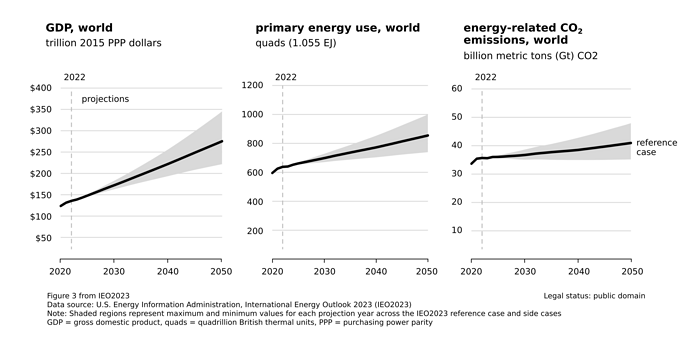The US Energy Information Administration (EIA), a part of the US Department of Energy, released its annual International Energy Outlook 2023 (IEO2023) report two days ago (cited below).
The report was launched at the Center for Strategic and International Studies in Washington DC by administrator Joseph DeCarolis and assistant administrator Angelina LaRose. The launch was videoed and uploaded to YouTube (00:57:12). And a transcript was also made public (cited below).
IEO2023 scenarios and results
The scenarios (which the EIA describe as “cases”) behind the IEO2023 are based on current ascertainable policy interventions and are therefore not remotely ambitious. DeCarolis (2023) provides an explanation — for which the first three paragraphs are repeated here (with emphasis added):
I want to share our approach to scenario analysis so that our results can be interpreted in the proper context.
There’s a lot of uncertainty about the future. We treat a portion of this uncertainty by running a limited number of cases, each with different assumptions about key drivers. Our approach is restrained by design; I would characterize our cases as a sober but plausible assessment of long-term global energy trends.
Starting with policy assumptions, we only model existing policy that is legally enforceable and we assume existing policy sunsets as currently codified in law. By contrast, many other outlooks assume continued or increased policy momentum on climate, and sometimes a prescriptive target, such as reaching net zero.
The greenhouse gas emissions trajectories to 2050 are first‑order sensitive to GDP growth assumptions and these were varied twice (2.6% pa as reference along with 1.8% and 3.4%). And second‑order-sensitive assumptions about technological learning, future crude oil prices, and related exogenous inputs were also parameter scanned. The EIA model leaves emissions to float — unlike most other energy system models which constrain emissions to net‑zero in 2050 or thereabouts. The underlying methodological question is whether models (and modelers) should reflect or preempt public policy.
The model results are far from encouraging. In no case did aggregate energy-related carbon emissions ever dip below 2022 levels (see figure below). The IEO2023 exploration nonetheless provides a benchmark and suggests that much stronger public policy measures as well as deep societal change are needed. Joe DeCarolis indicated as much when he remarked during discussions that there is a much wider “universe” — meaning solution space — to explore. I recommend you watch the video for a more complete picture.
Figure 3 from IEO2023. Aggregate energy‑related carbon emissions remain constant to 2050 under the low GDP growth case, otherwise they rise significantly.
Open sourcing plans
During the discussion, Joe DeCarolis indicated that the EIA plans to open‑source its tooling. The following passage starts at 00:47:30 on the YouTube and runs for 00:02:40. That clip is worth watching, a transcript follows (emphasis added).
Very quickly, I will say that with the modeling exercises that we do at EIA we try to be as transparent as possible. So I do want to say that upfront. Like, if you’re — if you want to dig into what we’ve done, you can read the narrative, you can download the data tables you can read all of the documentation for all of the modules there, you can request the source code, and we’re planning to make the source code publicly available under an open-source license. There’s still a lot of logistics to work through, but we’re trying to be as transparent as we possibly can. OK, so there’s that."
And this on the “next generation” suite now under development (emphasis added):
We’re in the process of retooling our models. So I had announced earlier that we’re taking a break from the Annual Energy Outlook in 2024 so that we can add some of the low-carbon pathways that we need to be able to model, so we’re going to be doing that. But on a parallel track — separate effort — we’re also building a next-generation model, OK? And I think the key is, by talking with internal and external stakeholders, we really need modeling to be nimble and flexible, right? We need to be able to look at a wide range of scenarios, and the considerations that we now need to bring to the model are increasing."
The 2024 International Energy Outlook (IEO2024) will not be produced next year so that staff can work on this new tooling. The current modeling suite is apparently showing its age, with some components dating back decades, apparently.
References
CSIS (11 October 2023). US EIA’s International Energy Outlook 2023. Washington DC, USA: Center for Strategic and International Studies (SCIS). YouTube. Duration: 00:57:12.
CSIS (11 October 2023). Event — US EIA’s International Energy Outlook 2023 — Transcript. Washington DC, USA: Center for Strategic and International Studies (CSIS). Presentation and discussion. Held Wednesday 11 October 2023 09:30 -0400 (EDT). Featuring Joseph DeCarolis, Angelina LaRose, and Joseph Majkut. Web version.
DeCarolis, Joseph (11 October 2023). US EIA’s International Energy Outlook 2023 — Joseph DeCarolis on LinkedIn. LinkedIn.
EIA (11 October 2023). International Energy Outlook 2023 — Landing page. US Energy Information Administration (EIA). Washington DC, USA. Contains links to the IEO2023 report and allied information.
Wikipedia article on the Energy Information Administration
▢
